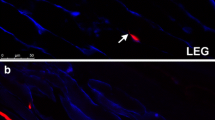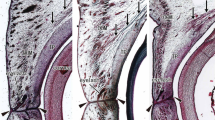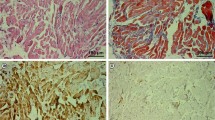Abstract
Mesectodern is an accurate term to describe the cellular origin of the connective tissue of the eye other than the eye muscles and vascular endothelium. The present study demonstrates that the tendons of origin and insertion, as well as the belly of the extraocular muscle, develops at the same time.
Similar content being viewed by others
References
Adams RD, Denny-Brown D, Pearson CM (1962) Embryology and histology of skeletal muscle. In: Diseases of muscle, 2nd edn. Harper, New York, pp 3–15
Arey LB (1942) Developmental anatomy. Saunders, Philadelphia, pp 129–133
Barer R (1948) The structure of the striated muscle fiber. Biol Rev 23:159–200
Butcher EO (1933) The development of striated muscle and tendon from the caudal myotomes in the albino rat, and the significance of myotomic cell arrangement. Am J Anat 53:177–189
Carr RW (1931) Muscle-tendon attachment in the striated muscle of fetal pig. Am J Anat 49:1–42
Fink WH (1953) The development of the extrinsic muscles of the eye. Am J Ophthalmol 36: 10–23
Fink WH (1956) The development of the orbital fascia. Am J Ophthalmol 42:269–278
Gilbert PW (1952) The origin and development of the head cavities in the human embryo. J Morphol 90:149–187
Gilbert PW (1954) The premandibular head cavities in the opossum,didelphys virginiana. J Morphol 95:47–75
Gilbert PW (1957) The origin and development of the human extrinsic ocular muscle. Contrib Embryol Carnegie Inst 36:59–78
Goss CM (1944) The attachment of the skeletal muscle fibers. Am J Anat 74:259–289
Hennemann E, Olsen CB (1965) Relations between structure and function in the design of skeletal muscles. J Neurophysiol 28:581–598
Hewer EE (1928) The development of muscle in the human foetus. J Anat 62:72–78
Iwasaki T (1958) Studies on the initial growth of the extraocular muscles of Japanese. Acta Soc Ophthalmol Jpn 62:2584–2607
Le Lieure C, Le Douarin N (1975) Mesenchymal derivatives in the neural crest: analysis of chimaeric quail and chick embryos. J Embryol Exp Morphol 34:125–154
Long ME (1947) Development of the muscle-tendon attachment in the rat. Am J Anat 81: 159–198
Mair WGP, Tome FMS (1972) Normal striated muscle. In: Atlas of the ultrastructure of diseases of human muscle. Longman (Churchill Livingstone) New York pp 1–11
Marshall AM (1881) On the head cavities and associated nerves in Elasmobranchs. Q J Microbiol Sci 21:72–97
Muir AR (1961) Observations on the attachment of myofibrils to the sarcolemma at the muscle-tendon junction. In: Boyd JD, Johnson FR, Lever SD (eds) Electron microscopy in anatomy. Academic Press, New York
Ozanics V, Jakobiec FA (1982) Prenatal development of the eye and its adnexa. In: Jakobiec (ed) Ocular anatomy, embryology and teratology. Philadelphia, Harper and Row, pp 11–96
Peace DC, Baker RF (1949) The fine structure of the mammalian skeletal muscle. Am J Anat 84:175–195
Porter KP (1954) The myo-tendon junction in larval forms ofAmblystoma punctatum. Anat Rec 118:342–368
Schultze O (1912) Ueber den direkten Zusammenhang von Muskelfibrillen und Sehnenfibrillen. Arch Mikr Anat 79:307–331
Sevel D (1981) A reappraisal of the origin of human extraocular muscles. Ophthalmology 88:1330–1338
Sevel D (1984) Development of the nerves of the extraocular muscles. In: Reinecke RD (ed) Strabismus II. Grune and Stratton, New York, pp 645–657
Sevel D (1986) The origins and insertions of the extraocular muscles: development, histologic features, and clinical significance. Trans Am Ophth Soc 84:488–526
Speidel CC (1939) Studies of living muscle: histological changes in single fibers of striated muscle during contraction and clotting. Am J Anat 65:471–529
Tuchmann-du Plessis H, David G, Haegel P (1972) Embryogenesis, illustrated human embryology. Chapmann and Hall, London, pp 88–91
Webb JN (1972) The development of human skeletal muscle with particular reference to muscle cell death. J Pathol 106:221–228
Author information
Authors and Affiliations
Additional information
Dedicated to Dr. G.K. von Noorden on the occasion of his 60th birthday
Rights and permissions
About this article
Cite this article
Sevel, D. Laboratory investigations Development of the connective tissue of the extraocular muscles and clinical significance. Graefe's Arch Clin Exp Ophthalmol 226, 246–251 (1988). https://doi.org/10.1007/BF02181190
Issue Date:
DOI: https://doi.org/10.1007/BF02181190




